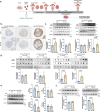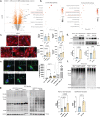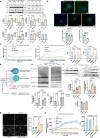Disruption of lysosomal proteolysis in astrocytes facilitates midbrain organoid proteostasis failure in an early-onset Parkinson's disease model
- PMID: 38200091
- PMCID: PMC10781970
- DOI: 10.1038/s41467-024-44732-2
Disruption of lysosomal proteolysis in astrocytes facilitates midbrain organoid proteostasis failure in an early-onset Parkinson's disease model
Abstract
Accumulation of advanced glycation end products (AGEs) on biopolymers accompanies cellular aging and drives poorly understood disease processes. Here, we studied how AGEs contribute to development of early onset Parkinson's Disease (PD) caused by loss-of-function of DJ1, a protein deglycase. In induced pluripotent stem cell (iPSC)-derived midbrain organoid models deficient for DJ1 activity, we find that lysosomal proteolysis is impaired, causing AGEs to accumulate, α-synuclein (α-syn) phosphorylation to increase, and proteins to aggregate. We demonstrated these processes are at least partly driven by astrocytes, as DJ1 loss reduces their capacity to provide metabolic support and triggers acquisition of a pro-inflammatory phenotype. Consistently, in co-cultures, we find that DJ1-expressing astrocytes are able to reverse the proteolysis deficits of DJ1 knockout midbrain neurons. In conclusion, astrocytes' capacity to clear toxic damaged proteins is critical to preserve neuronal function and their dysfunction contributes to the neurodegeneration observed in a DJ1 loss-of-function PD model.
© 2024. The Author(s).
Conflict of interest statement
The authors declare no competing interests.
Figures






Similar articles
-
Activation of β-Glucocerebrosidase Reduces Pathological α-Synuclein and Restores Lysosomal Function in Parkinson's Patient Midbrain Neurons.J Neurosci. 2016 Jul 20;36(29):7693-706. doi: 10.1523/JNEUROSCI.0628-16.2016. J Neurosci. 2016. PMID: 27445146 Free PMC article.
-
Therapeutic functions of astrocytes to treat α-synuclein pathology in Parkinson's disease.Proc Natl Acad Sci U S A. 2022 Jul 19;119(29):e2110746119. doi: 10.1073/pnas.2110746119. Epub 2022 Jul 15. Proc Natl Acad Sci U S A. 2022. PMID: 35858361 Free PMC article.
-
Impaired Autophagic-Lysosomal Fusion in Parkinson's Patient Midbrain Neurons Occurs through Loss of ykt6 and Is Rescued by Farnesyltransferase Inhibition.J Neurosci. 2023 Apr 5;43(14):2615-2629. doi: 10.1523/JNEUROSCI.0610-22.2023. Epub 2023 Feb 14. J Neurosci. 2023. PMID: 36788031 Free PMC article.
-
From 2D to 3D: Development of Monolayer Dopaminergic Neuronal and Midbrain Organoid Cultures for Parkinson's Disease Modeling and Regenerative Therapy.Int J Mol Sci. 2023 Jan 28;24(3):2523. doi: 10.3390/ijms24032523. Int J Mol Sci. 2023. PMID: 36768843 Free PMC article. Review.
-
Organoid and pluripotent stem cells in Parkinson's disease modeling: an expert view on their value to drug discovery.Expert Opin Drug Discov. 2020 Apr;15(4):427-441. doi: 10.1080/17460441.2020.1703671. Epub 2020 Jan 3. Expert Opin Drug Discov. 2020. PMID: 31899983 Free PMC article. Review.
Cited by
-
Astrocytes: The Stars in Neurodegeneration?Biomolecules. 2024 Feb 28;14(3):289. doi: 10.3390/biom14030289. Biomolecules. 2024. PMID: 38540709 Free PMC article. Review.
-
Experimental Cell Models for Investigating Neurodegenerative Diseases.Int J Mol Sci. 2024 Sep 9;25(17):9747. doi: 10.3390/ijms25179747. Int J Mol Sci. 2024. PMID: 39273694 Free PMC article. Review.
-
Generation of Neural Organoids and Their Application in Disease Modeling and Regenerative Medicine.Adv Sci (Weinh). 2025 Aug;12(29):e01198. doi: 10.1002/advs.202501198. Epub 2025 May 24. Adv Sci (Weinh). 2025. PMID: 40411400 Free PMC article. Review.
-
Extracellular flux assay (Seahorse assay): Diverse applications in metabolic research across biological disciplines.Mol Cells. 2024 Aug;47(8):100095. doi: 10.1016/j.mocell.2024.100095. Epub 2024 Jul 18. Mol Cells. 2024. PMID: 39032561 Free PMC article. Review.
-
Age-Related Neurodegenerative Diseases: A Stem Cell's Perspective.Cells. 2025 Feb 27;14(5):347. doi: 10.3390/cells14050347. Cells. 2025. PMID: 40072076 Free PMC article. Review.
References
MeSH terms
Grants and funding
LinkOut - more resources
Full Text Sources
Medical
Research Materials
Miscellaneous

